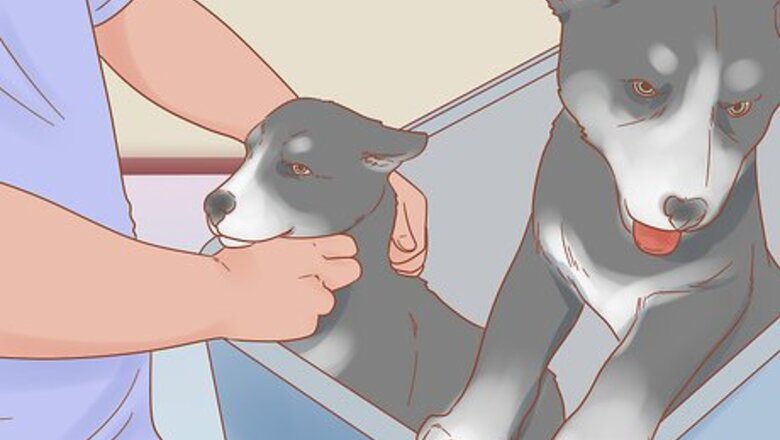
views
X
Trustworthy Source
American Kennel Club
The American Kennel Club (AKC) is a purebred dog pedigree registry in the United States. The AKC advocates for the responsible ownership of dogs and promotes purebred dog events, such as the Westminster Dog Show.
Go to source
They are loyal and good-natured dogs who have a genuine love for life, and lots of people want them as pets. However, Huskies can also be stubborn and quite difficult to train, so you must be up to the task. If you are considering owning a Husky, decide if you have the time, patience, energy, and dedication to help him live a long, happy, and fulfilled life.
Training Your Husky
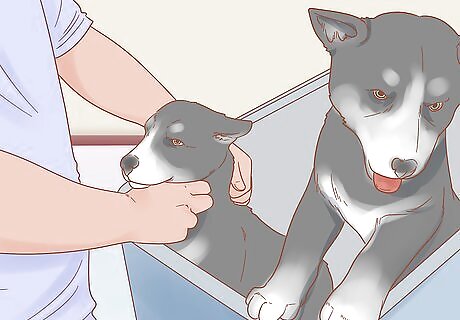
Socialize your Husky puppy. Socialization teaches your puppy how to interact properly with various aspects of his environment (e.g., people, other dogs), which will help him grow into a confident and well-mannered adult dog. Allow your puppy to spend time around different people and experience various sights and sounds. Puppy kindergarten class is a great way to teach your Husky puppy how to interact with other dogs. Enroll your puppy Husky in puppy kindergarten when he is four to five months old. Other than puppy kindergarten, you can socialize your puppy by exposing him to different situations in his environment, such as the sounds of passing cars and honking horns. You can also invite your friends over to help him become comfortable with new people. Taking your puppy to a park is another good way to expose him to different people, sights, and sounds. Observe your puppy as he explores his new world. If he appears frightened or wary of certain experiences, do not continue to expose him to those situations.

Enroll your adult Husky in an obedience training class. By nature, Huskies are very independent and intelligent dogs. However, they can also be stubborn, which can make training difficult. Obedience classes are ideal for training your Husky. Enroll your Husky in a "junior" obedience class when she is 4 months old and follow up with adult training around 12 months. For a well-behaved dog, it is imperative you begin training your Husky at a young age. Be aware that your Husky may use her intelligence to differentiate between training class and home — she may perform the training exercises perfectly in class, then misbehave when she gets home. Frustrating as this may be, continue to practice and reinforce her training at home. When training a husky, consistency is key!

Crate train your Husky. This is particularly important if you have a Husky puppy. Crate training will help the housetraining process go more smoothly—he will not want to urinate or defecate where he sleeps. In addition, crate training will turn his crate into a safe space to go if your Husky feels scared or needs to rest. Your Husky’s crate is not a place of punishment. Sending him to his crate when he misbehaves may cause your Husky to develop a negative association with his crate.
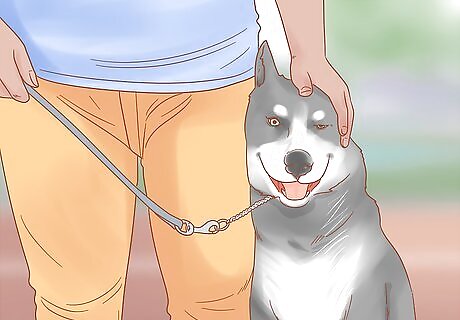
Leash train your Husky. If you let your Husky off her leash, she will likely dash away from you to go for a good run or happily pursue something far away. She may love you as her owner, but, if given the chance, her love of running and chasing (and maybe even her predatory instincts) may take over. Because of this, leash training your Husky is essential. Leash training will also prevent your Husky from pulling on the leash. If she begins to pull, you can either stand still and call her back to you or smoothly and immediately walk in the opposite direction of the pull. Do not jerk or pull back on the leash — this may encourage your Husky to pull even harder. Do not use a retractable leash — this could cause your Husky to pull even more, since pulling will let her go further. If you have a puppy, let her sniff and "explore" her leash and collar in the house before you try walking her outside. Obedience training classes can help you leash train your Husky.
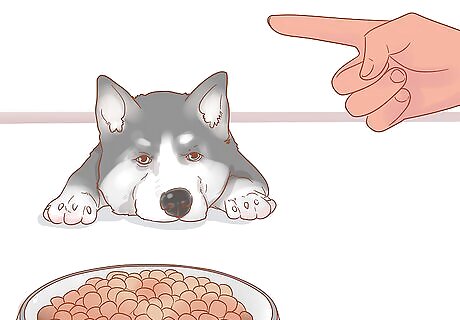
Establish that you are your Husky’s leader. Huskies are pack animals and expect to have a clear leader of the pack. Your Husky should see you as his leader. A good way to establish this leadership is to make him wait to eat. By controlling when he eats, your Husky will see you as the sole source of his food and resources, and thus his leader. Another way to establish your leadership with your Husky is to lead during your walks with him. By taking the lead, you are confidently showing him that he is to follow you, rather than the other way around. Do not be surprised if your Husky occasionally tries to become the leader of the pack. If he does, remember to be firm and consistent with your leadership. Do not establish your leadership through bullying or hitting your dog. Your Husky is unlikely to trust and respect you as his leader if you try to establish your leadership through physical intimidation.
Exercising and Playing With Your Husky
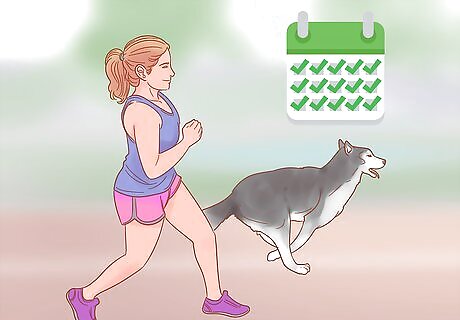
Exercise with your Husky on a daily basis. Huskies are working dogs, with their origins in Siberia where they pulled heavy sleds over long distances. Thus, it comes as no surprise that Huskies require daily, vigorous exercise (at least 30 to 60 minutes) to release pent-up energy. Long walks are a great way to exercise your Husky. To encourage your Husky’s "working dog" side (and if you are feeling adventurous), tie her leash or harness to a bicycle or wheelbarrow and let her pull you. Do not attempt this if she is not well trained. Playing fetch and going hiking with your Husky are other good ways to exercise her. If you live by the water, you can take your Husky swimming. Be mindful that Huskies are very energetic dogs, and are almost always ready to play and exercise. Make sure you have the energy to keep up with her! EXPERT TIP Colleen Demling-Riley, CPDT-KA, CBCC-KA, CDBC Colleen Demling-Riley, CPDT-KA, CBCC-KA, CDBC Canine Behavior Consultant Colleen Demling-Riley (CPDT-KA, CBCC-KA, CDBC) is a Canine Behavior Consultant and the Founder of Pawtopia Dog Training. With more than 20 years of experience, she specializes in creating and customizing dog management programs for dog owners. She is a Certified Pet Dog Trainer-Knowledge Assessed, Certified Behavior Consultant Canine-Knowledge Assessed, Certified Dog Behavior Consultant, and American Kennel Club Canine Good Citizen Evaluator. Colleen is a member of the International Association of Canine Professionals and has been a featured expert in national media including the New York Times, Woman’s Day, Readers Digest, Cosmopolitan, and Yahoo.com. Colleen Demling-Riley, CPDT-KA, CBCC-KA, CDBC Colleen Demling-Riley, CPDT-KA, CBCC-KA, CDBC Canine Behavior Consultant Huskies have high energy levels that set them apart from similar breeds like Malamutes. Huskies require plenty of exercise to release their energy. If they don't have outlets to release their energy, Huskies will often attempt escape by trying to open gates or digging under fences.

Secure your yard to prevent escape. Huskies are master escape artists. If you let your Husky exercise in the backyard, prevent his escape by enclosing your yard with a six-foot fence. This may not be enough, however — your Husky’s love of digging may lead him to try to dig his way out of your yard. To prevent a ‘"digging" escape, have your fence sunk at least several inches into the ground. You could even place concrete or strong mesh wiring at the base of the fence to prevent digging. Contact a fencing company to reconfigure your fence such that your Husky cannot dig his way out. If your Husky has managed to dig some holes, you can fill them with cinder blocks to discourage further digging. Always supervise your Husky when he is out in the yard. Although your Husky loves the outdoors, leaving him in the backyard unattended will probably make him feel lonely and bored, which could lead to destructive digging.

Find a playmate for your Husky. Huskies are very social animals. Your Husky would love to have another dog with whom she can play and exercise. An ideal playmate will be a dog that is about the same size as your Husky and can keep up with her. Allow your Husky to meet other dogs so that she can choose a playmate.
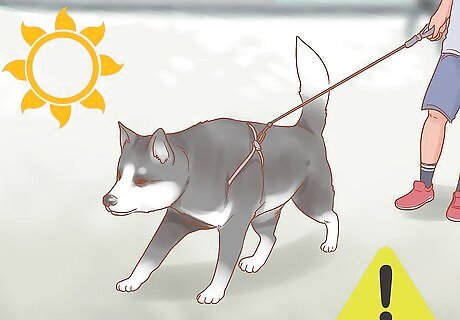
Do not exercise your Husky in hot weather. Huskies have a double coat, which makes them best suited for cold climates. This does not necessarily mean that you should not own a Husky if you live in a warm climate — you will just need to use more caution when playing and exercising with him during the warmer months of the year. If you live in a warmer climate, exercise your Husky only in the early morning when it is not too hot outside. Your Husky could overheat if he is outside for too long during the heat of the summer. Try to keep him inside during the hottest part of the day.
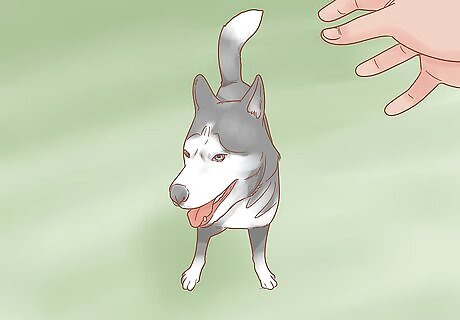
Entertain your Husky. Your Husky is very intelligent, and will need mental stimulation to keep her happily busy and entertained. Kong toys are especially good for Huskies: they are durable and mentally challenge your Husky to figure out how to get the food out. Fill the Kong toy with your Husky's favorite treats. Be mindful that Huskies can be very destructive. Choose durable chew toys that will keep your Husky busy, but cannot be easily destroyed. Other than toys, teaching your Husky various tricks (e.g., playing dead, playing fetch) will provide her with plenty of mental stimulation.
Feeding and Grooming Your Husky
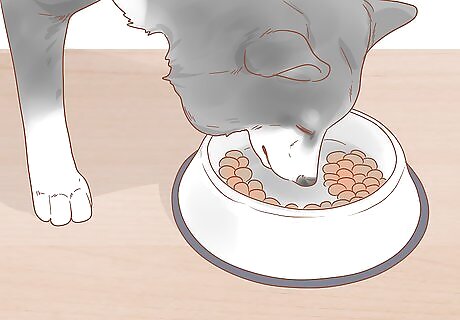
Feed your Husky high-quality dog food. Huskies were originally bred to survive on a small amount of food. Therefore, your Husky will not need to eat a lot of calories to be healthy and have the energy to play and exercise. Feed your Husky either once or twice daily and avoid exercise for at least 90 minutes after eating. Your Husky may need more or less food, depending on such factors as her size, age, and health status. If you have a Husky puppy, begin by feeding her three times a day — early morning, early afternoon, and evening. When she is three to four months old, she will likely cut herself back to twice-daily meals. Human food and canned food may cause your Husky to become a finicky eater and/or develop diarrhea. If you purchased your Husky from a breeder, he or she can recommend dog foods for your Husky to eat. You can also ask your veterinarian and other Husky owners for food recommendations.
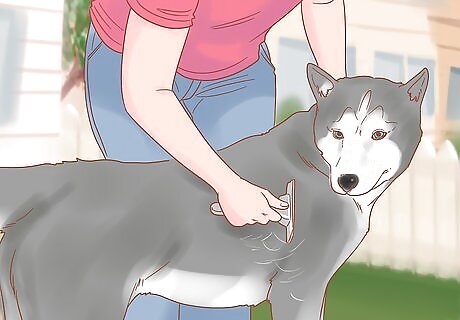
Brush your Husky’s coat. By nature, Huskies are very clean dogs. They have little to no dog odor and groom themselves frequently, so you will not need to do much extra grooming. However, Huskies do shed quite a bit, particularly during the spring and fall when they blow their coats (complete shedding of the undercoat). The "blowing coat" period lasts for at least three weeks. Brush your Husky with a slicker brush at least once a week throughout the year to remove dead hair and keep his coat fresh and shiny. Slicker brushes are available at your local pet store. Do not shave your Husky's coat in the summer. You may think that shaving his coat will help cool him off, but you are actually removing his protection from harmful ultraviolet rays.
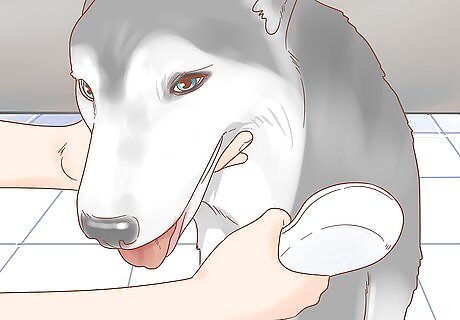
Bathe your Husky. Since Huskies do an excellent job of keeping themselves so clean, they rarely need baths. You will probably need to bathe your Husky only once a year. If you are not able to bathe your Husky on your own, you may prefer to take her to a dog groomer.

Trim your Husky’s nails. Your Husky’s nails should be trimmed once every one to two weeks. If your Husky’s energy and size make it difficult for you to trim his nails on your own, schedule a nail-trimming appointment with your veterinarian. Keep in mind that he may keep his nails naturally trimmed down with his exercise and play.

Brush your Husky’s teeth. If you can manage it, brush your Husky’s teeth at least two to three times a week. You can purchase veterinarian-approved toothpaste through your veterinarian. Brushing your dog’s teeth will not only keep her breath fresh, but will also prevent plaque and tartar buildup, both of which can lead to serious dental and systemic diseases. Consider talking with your veterinarian for extra guidance on brushing your Husky’s teeth. If you are not able to brush your dog’s teeth, you can schedule a dental cleaning with your veterinarian. However, this requires general anesthesia and can be very expensive.

















Comments
0 comment